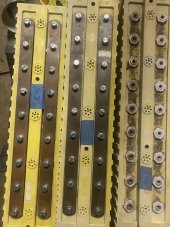ClinicalScientist
New Member
- Joined
- Feb 21, 2022
- Messages
- 25
Hello guys. Looking for some advice before I make an explosive mistake. I picked up these older Winston 1000Ah 3.2 volt cells for $200. Seemed like a good deal. My intention was to wire them in series to make 24 volts with the assumption that each terminal pair was a separate confined cell. Turns out that’s not quite the case. There are separate cathodes and anodes, but upon disassembly I found they share electrolyte fluid for all “cells” in each battery. Can I make a 8s3p battery out of these?






